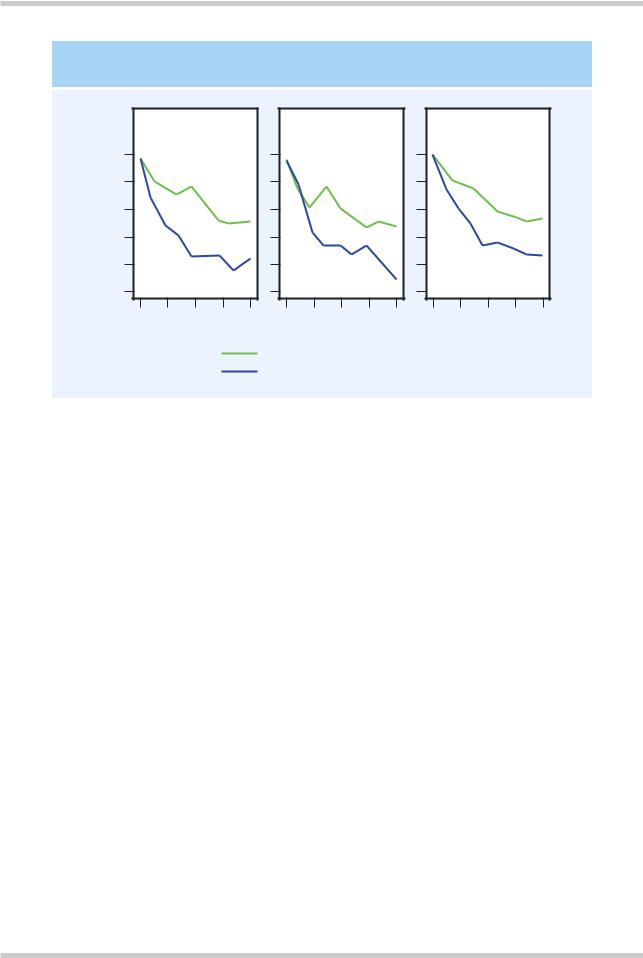
- •Contents
- •Other atlases in this series include:
- •Preface
- •Foreword
- •History and Classification
- •The Acute Illness
- •The Chronic Illness
- •Factors Affecting Prognosis
- •References
- •Genetics
- •Environmental Influences
- •Early Environmental Factors
- •Obstetric Complications
- •Prenatal Infection
- •Neurodevelopmental Abnormality
- •Later environmental factors
- •Substance Misuse
- •Social and Psychological Factors
- •Conclusion
- •References
- •Structural Imaging and Anatomical Studies
- •Functional Brain Imaging
- •Neurochemistry
- •Neuropsychology
- •Psychophysiology
- •References
- •Introduction
- •Classification of Antipsychotics
- •Neurochemistry of Schizophrenia and Mechanisms of Action of Antipsychotics
- •Dopamine
- •Serotonin
- •Other Neurotransmitters
- •Efficacy of Antipsychotics in the Acute Phase of Treatment
- •Pharmacotherapy as Maintenance Treatment in Schizophrenia
- •Low-Dose Antipsychotics
- •Intermittent or Targeted Medication
- •Acute Neurological Side-Effects
- •Medium-Term Neurological Side-Effects
- •Chronic Neurological Side-Effects
- •Neuroendocrine Effects
- •Idiosyncratic Effects
- •Cardiac Conduction Effects of Antipsychotics
- •Clozapine
- •Risperidone
- •Olanzapine
- •Quetiapine
- •Amisulpride
- •Ziprasidone
- •New Antipsychotics Currently in Phase III Clinical Trials
- •Iloperidone
- •Aripiprazole
- •Negative Symptoms
- •Cognition
- •Affective Symptoms
- •The Future
- •References
- •Psychological Therapies
- •Cognitive Behavioral Therapy
- •Neurocognitive Remediation
- •Compliance with Drug Treatment
- •Family Treatments
- •Early Intervention
- •Managing Schizophrenia in the Community
- •References

PERCENTAGE CHANGE IN POSITIVE PSYCHOTIC SYMPTOMS
|
|
|
Elevated mood |
|
||
change |
100 |
|
|
|
|
|
80 |
|
|
|
|
|
|
60 |
|
|
|
|
|
|
Percentage |
|
|
|
|
|
|
40 |
|
|
|
|
|
|
20 |
a vs. b |
|
|
|
||
|
|
|
|
|
||
|
0 |
p < 0.05 |
|
|
|
|
|
|
|
|
|
|
|
|
|
0 |
1 |
2 |
3 |
4 |
|
|
|
Placebo |
(a) |
|
|
|
|
|
Pimozide |
(b) |
|
|
|
Depressed mood |
|
||
a vs. b |
|
|
|
|
p < 0.01 |
|
|
|
|
0 |
1 |
2 |
3 |
4 |
Time (weeks)
No consistant |
|
|
||
|
mood change |
|
||
a vs. b |
|
|
|
|
p < 0.05 |
|
|
|
|
0 |
1 |
2 |
3 |
4 |
Figure 4.12 Change in positive psychotic symptoms in patients randomized to either the antipsychotic pimozide or to placebo. The groups were subdivided on the basis of the presence of elevated mood, depressed mood or no consistent mood change. The fact that pimozide significantly reduced positive psychotic symptoms in all three groups provided evidence that the ‘neuroleptics’ are in fact antipsychotic rather than ‘antischizophrenic’. Figure reproduced with permission from Johnstone EC, Crow TJ, Frith CD, Owens DG. The Northwick Park “functional” psychosis study: diagnosis and treatment response. Lancet 1988;2:119–25
drive to inhibitory GABAergic neurons which further regulate the excitatory neurons acting on areas such as the frontal cortex and the limbic regions. Thus, with decreased inhibitory control these neurons may increase firing in these areas and produce psychotic symptoms23. Thus, reducing glutamate release at all glutamate receptors may also have a role in improving symptoms in schizophrenia.
EFFICACY OF ANTIPSYCHOTICS IN THE ACUTE PHASE OF TREATMENT
The best known large-scale clinical trial, which gives a good idea of the treatment effect to be expected with antipsychotics, was carried out by the National Institutes of Mental Health, in the USA24. This study involved four treatment groups (chlorpromazine, thioridazine, fluphenazine and
placebo) with 90 randomly allocated subjects in each. The subjects were treated for 6 weeks and rated on 14 different symptoms in addition to global clinical improvement. In this study 75% of subjects in the chlorpromazine, thioridazine and fluphenazine groups showed significant improvement, 5% failed to be helped and 2% deteriorated. In the placebo group only 25% of patients showed significant improvement, and over 50% were unchanged or worse.
Johnstone and co-workers25, showed that pimozide was antipsychotic (i.e. reducing the positive symptoms of psychosis) in patients with ‘functional’ psychosis, regardless of whether the patients had prominent manic or depressive symptoms or were euthymic. This proved that ‘neuroleptics’, as they were then popularly called, were truly antipsychotic rather than simply antischizophrenic (Figure 4.12).
©2002 CRC Press LLC
